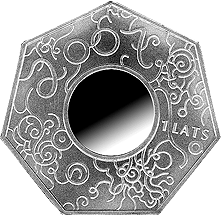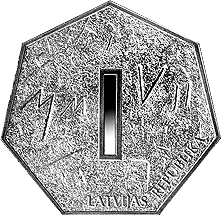

Face value: 1 lats
Weight: 27.0 g, diameter (the longest diagonal): 38.61 mm
Metal: silver, fineness .999, quality: proof
Struck in 2006 by Münze Österreich (Austria).
Artists: Ilmars Blumbergs (graphic design), Janis
Strupulis (plaster model)
Obverse
The Arabic numeral 0 is in the centre of the heptagon, with the year 2007
arranged above it to the left, and the inscription 1 LATS placed to the right,
against a background of an Oriental pattern of curvy lines.
Reverse
The Roman numeral I is in the centre of the
heptagon, with the year MMVII split and arranged on both sides of it, against a
background of an ornament of straight lines forming the shapes of Roman
numerals.
Edge
Plain.
The Coin of Digits is an alien coming from a faraway unknown. Its unusual
heptagon shape and the quaint characters on the metallic surface seem to invite
one to seek for some ancient message.
Since time immemorial the numeral seven has been considered a mysterious, even supernatural and sacred number, a sign of perfection and accomplishment. It incorporates the symbolism of both the number three associated with the heaven and four associated with the earth. There are several references to the number seven in the Bible, bearing both positive and negative connotations, but always expressing completeness: a book sealed with seven seals; the seven bowls of God's wrath. The seven wonders of the world are well known to this day.
In Latvian, the word "cipars" (digit) has other meanings as well: a trick, a joke, a prank. Thus lofty symbolism has always co-existed with the down-to-earth, and the number seven bears equally strong associations with the seven dwarfs and with the seven kids and the angry wolf from fairy-tales.
On the obverse of the coin, the seven edges provide a strict frame for an infinite expanse of signs where the number 2007 and the central disc incorporating a shining zero sign stand out amidst a lattice of Oriental ornaments. It is a reminder of Arabic numerals, borrowed from Indian symbols and used nowadays to represent numbers.
The reverse depicts a clean-cut Roman numeral one, like a soldier standing to attention in the centre of the coin. The Roman numerals are considered to possess a special aura of importance. Hence instead of the commonly used Arabic numerals they appear in the titles of monarchs and references to notable anniversaries.
The Coin of Digits reminds us that numbers are powerful symbols created by people. Ilmars Blumbergs, the designer of the coin, says: "In the modern world, circulation of information is of primary significance. We use digits for creating, saving and transmitting information electronically. It is just two digits: 0 and 1. Ideas expressed as a digital code become available to anyone. These two digits bring the world closer together."
